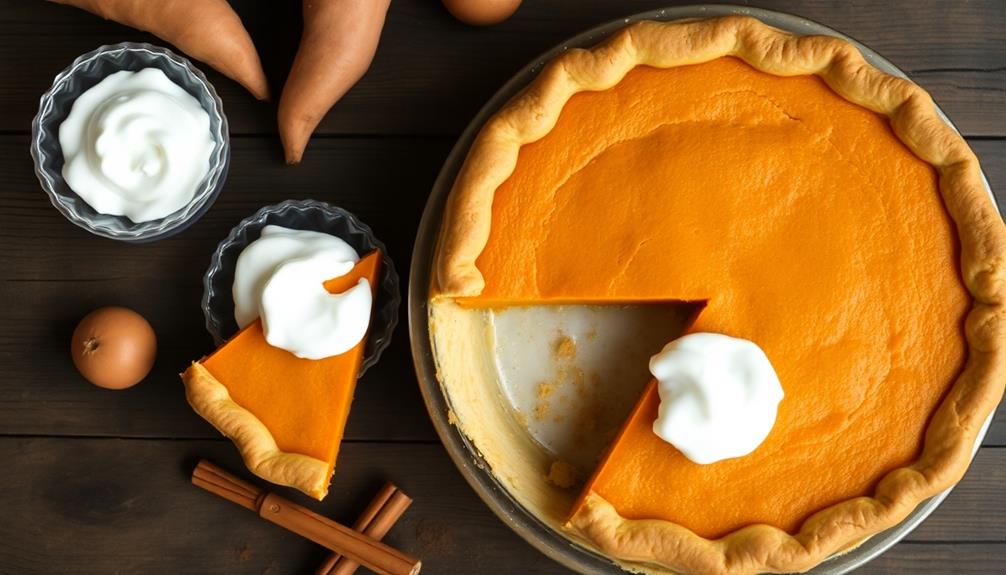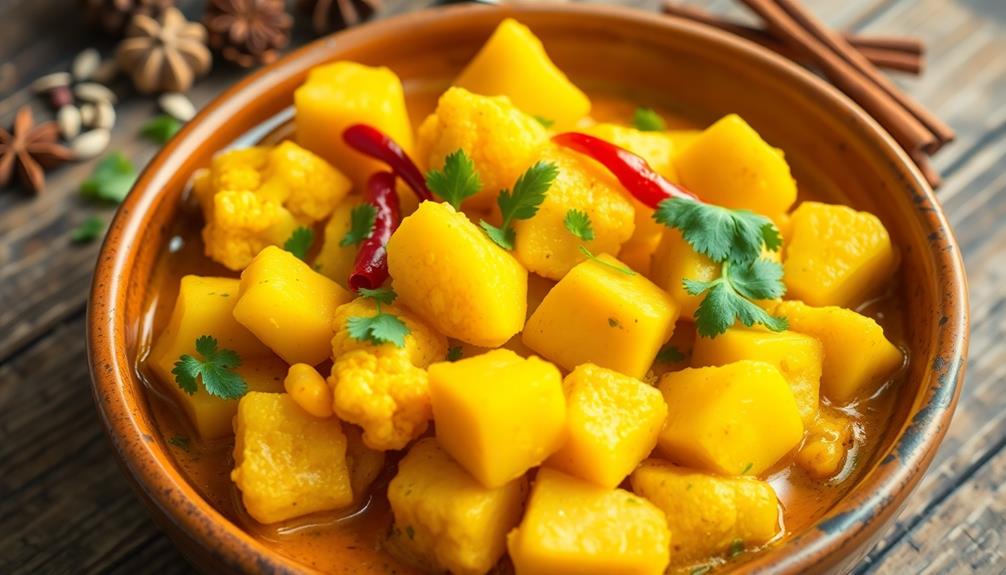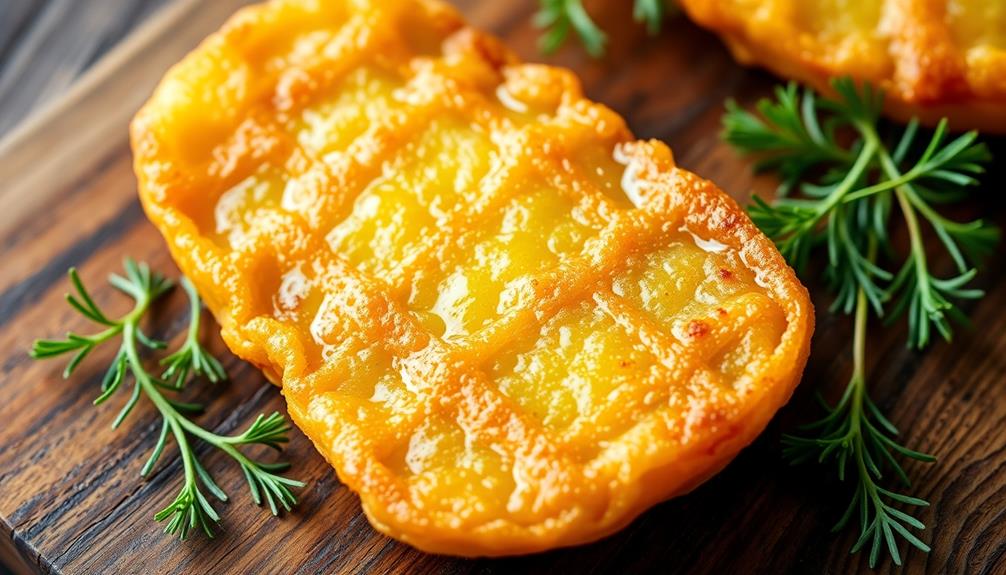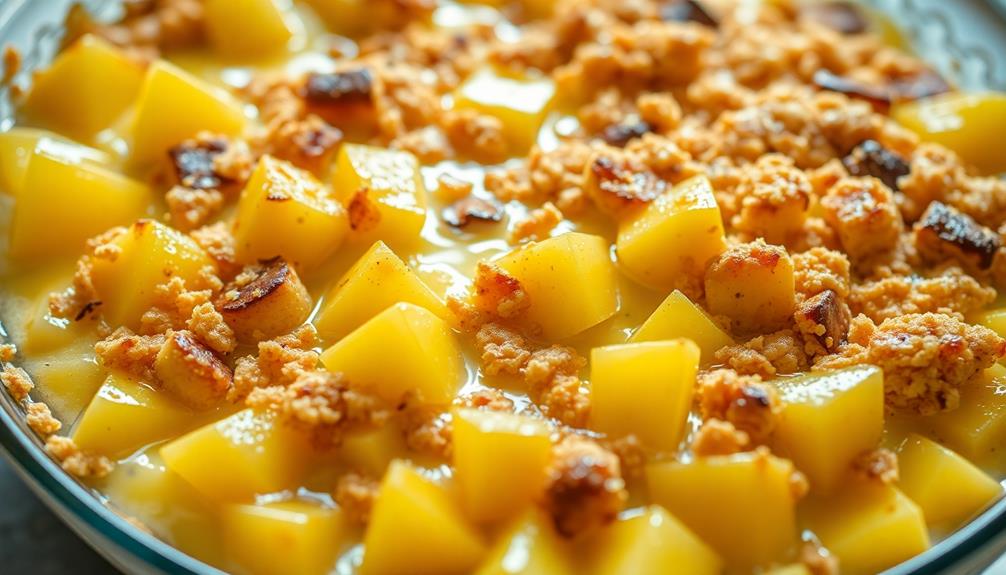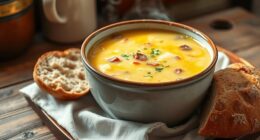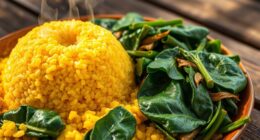Sweet potato pie is a delicious Southern dessert you'll love! It's made with mashed sweet potatoes, warm spices, and a flaky crust. This comforting treat has roots in American history, blending Native American and African influences. You'll find it's perfect for holidays and special gatherings. To make one, you'll mix cooked sweet potatoes with sugar, butter, and spices, then pour the filling into a pie crust. Bake it until golden brown, and you've got a slice of heaven! The creamy, spiced filling and buttery crust create a perfect blend of flavors. There's so much more to discover about this tasty pie!
Key Takeaways
- Sweet potato pie is a dessert originating in the American South, combining mashed sweet potatoes, sugar, and spices in a flaky crust.
- The recipe typically includes ingredients like cooked sweet potatoes, brown sugar, butter, evaporated milk, and eggs for the filling.
- Baking involves a two-step process: 15 minutes at 425°F, followed by 35-40 minutes at 350°F, with crust protection if needed.
- Fresh sweet potatoes are preferred over canned for better flavor, and the pie can be customized with various spices and toppings.
- Sweet potato pie is often served during holidays and special gatherings, paired with whipped cream or ice cream.
History
Many historians trace the origins of sweet potato pie back to the American South during the colonial era. You might be surprised to learn that it's been around for centuries!
Native Americans were already growing sweet potatoes when European settlers arrived. These settlers quickly learned to love this tasty vegetable.
As time went on, sweet potatoes became a staple crop in the South. African slaves, who were skilled farmers, played a big role in growing them.
They brought their own cooking techniques and flavors to the kitchen. This mix of cultures led to the creation of sweet potato pie as we know it today.
Recipe
Sweet potato pie is a beloved Southern dessert that combines the rich, earthy flavor of sweet potatoes with warm spices and a flaky crust. This comforting treat is often served during fall and winter holidays, but it's delicious any time of year.
This recipe yields a creamy, smooth filling encased in a buttery crust. The natural sweetness of the sweet potatoes is enhanced by brown sugar and a blend of spices, creating a perfectly balanced dessert that's sure to become a family favorite.
- 2 cups cooked and mashed sweet potatoes
- 1 cup packed brown sugar
- 1/2 cup unsalted butter, melted
- 1/2 cup evaporated milk
- 2 large eggs
- 1 teaspoon ground cinnamon
- 1/2 teaspoon ground nutmeg
- 1/4 teaspoon ground ginger
- 1/4 teaspoon salt
- 1 unbaked 9-inch pie crust
Preheat the oven to 425°F (220°C). In a large bowl, combine the mashed sweet potatoes, brown sugar, melted butter, evaporated milk, eggs, cinnamon, nutmeg, ginger, and salt. Mix until smooth and well combined.
Pour the mixture into the unbaked pie crust and smooth the top with a spatula. Bake for 15 minutes, then reduce the temperature to 350°F (175°C) and continue baking for 35-40 minutes, or until a knife inserted near the center comes out clean. Allow the pie to cool completely before serving.
For best results, use fresh sweet potatoes rather than canned. To prepare them, peel and cut the sweet potatoes into chunks, then boil until tender. Drain and mash thoroughly before using in the recipe.
If the pie crust edges begin to brown too quickly during baking, cover them with aluminum foil to prevent burning. For a decorative touch, consider adding a border of whipped cream or chopped pecans around the edge of the cooled pie before serving.
Cooking Steps
Get ready to bake a delicious sweet potato pie with these easy steps!
You'll start by preheating your oven and preparing the pie crust.
Then, you'll mix the sweet potato filling, pour it into the crust, and bake for 45 minutes at 425°F.
Step 1. Preheat Oven to 425°F

Before diving into the pie-making process, it's crucial to preheat your oven to 425°F (218°C). This step is super important because it ensures your pie will bake evenly and come out just right.
While your oven is heating up, you'll have time to prepare the other ingredients and get everything ready. Make sure your oven rack is in the middle position. This helps the pie cook perfectly from all angles.
If you have an oven thermometer, use it to double-check the temperature. Sometimes ovens can be a bit off, and you want to make sure it's exactly 425°F.
While you're waiting, gather all your ingredients and tools. This way, you'll be ready to go as soon as the oven is hot.
Remember, a properly preheated oven is key to getting that golden-brown crust and perfectly cooked filling. It might seem like a small step, but it makes a big difference in how your sweet potato pie turns out.
Step 2. Prepare Pie Crust
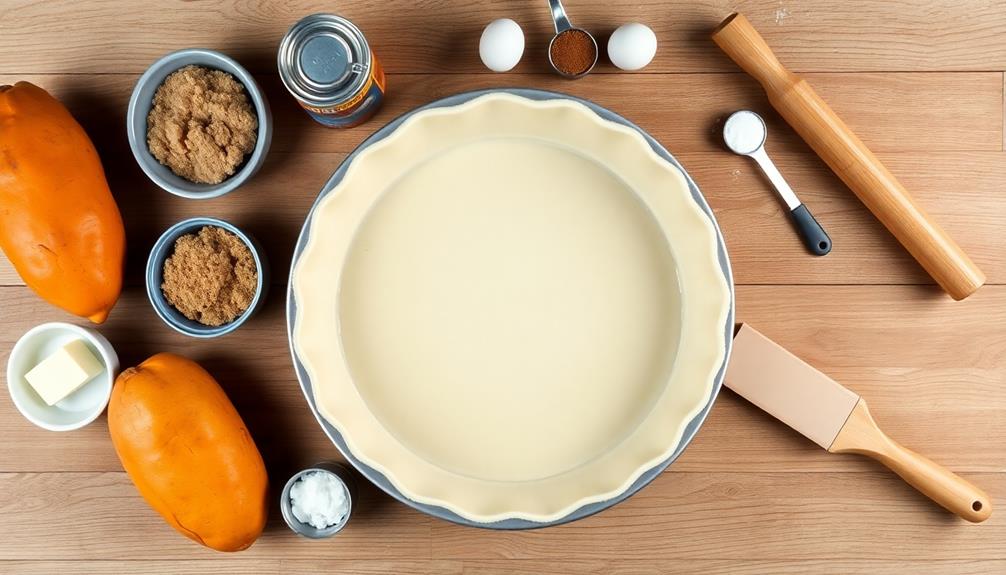
The pie-crust preparation is a crucial step in creating your sweet potato pie masterpiece. Start by gathering your ingredients: flour, salt, cold butter, and ice water.
In a large bowl, mix the flour and salt. Cut the cold butter into small cubes and add them to the flour mixture. Using your fingertips or a pastry cutter, work the butter into the flour until it resembles coarse crumbs.
Slowly add ice water, one tablespoon at a time, mixing gently with a fork. Stop when the dough starts to come together. Don't overwork it!
Form the dough into a disk, wrap it in plastic, and chill it in the fridge for at least 30 minutes.
Once chilled, roll out the dough on a floured surface. Aim for a circle about 12 inches in diameter. Carefully transfer the rolled dough to your pie dish. Trim the edges, leaving a slight overhang.
Fold the excess under and crimp the edges to create a pretty border. Your pie crust is now ready for the delicious sweet potato filling!
Step 3. Mix Sweet Potato Filling

With your pie crust prepared, it's time to focus on the star of the show: the sweet potato filling.
Start by peeling and cubing 2 pounds of sweet potatoes. Boil them in a large pot until they're soft and tender. Drain the potatoes and mash them until smooth.
In a mixing bowl, combine the mashed sweet potatoes with 1/2 cup of melted butter, 1 cup of sugar, and 1/2 cup of milk. Mix these ingredients well, creating a creamy base for your filling.
Now, it's time to add some flavor! Crack in 2 eggs and pour in 1 teaspoon of vanilla extract. For a warm, cozy taste, sprinkle in 1/2 teaspoon each of ground cinnamon and nutmeg.
Using an electric mixer or a whisk, blend all the ingredients together until they're smooth and well combined. Your filling should look creamy and have a beautiful orange color.
Give it a quick taste to make sure it's sweet enough. If needed, add a bit more sugar. Your sweet potato filling is now ready to be poured into the waiting pie crust!
Step 4. Pour Filling Into Crust
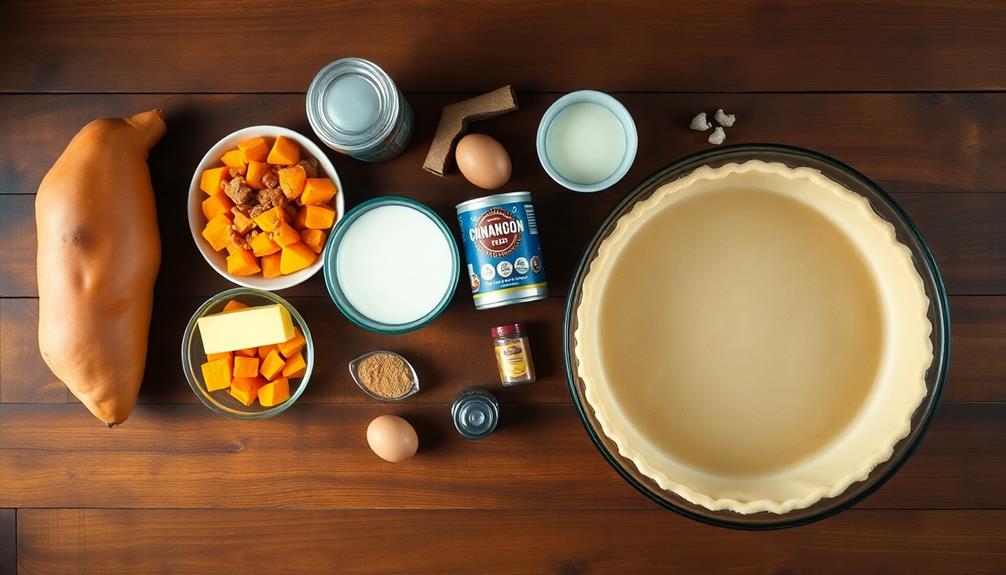
Now that your filling is prepared, it's time to pour it into the waiting pie crust. Grab your bowl of sweet potato mixture and give it one last stir to make sure everything's well combined.
Place your pie dish with the crust on a flat, stable surface. Carefully tip the bowl and start pouring the filling into the crust. Go slowly to avoid spills and to ensure an even distribution.
You'll notice the rich, orange color of the sweet potatoes as it fills the crust. Doesn't it look delicious already?
Use a spatula to scrape out every last bit of the filling. You don't want to waste any of that yummy goodness!
Once you've poured it all in, gently tap the pie dish on the counter a few times. This helps remove any air bubbles trapped in the filling.
Now, use the back of a spoon or a rubber spatula to smooth out the top of the filling. Make sure it's nice and even.
Your pie is almost ready for the oven! Take a moment to admire your work before moving on to the next step.
Step 5. Bake for 45 Minutes

Once you've smoothed out the filling, it's time to bake your sweet potato pie. Preheat your oven to 375°F (190°C) and make sure the rack is in the middle position. Carefully place your pie on the rack and set a timer for 45 minutes.
As your pie bakes, you'll notice wonderful aromas filling your kitchen. The custard will start to set, and the crust will turn a golden brown. Keep an eye on your pie, but resist the urge to open the oven door too often. This can cause the temperature to drop and affect the baking process.
After about 35 minutes, check on your pie. If the edges of the crust are browning too quickly, you can cover them with strips of aluminum foil. This will prevent them from burning while the center continues to cook.
Your pie is done when the filling is set but still slightly jiggly in the center. You can test this by gently shaking the pie dish. If it wobbles like gelatin, it's ready! Remove it from the oven and let it cool on a wire rack.
Final Thoughts
In light of all we've discussed, sweet potato pie stands out as a beloved dessert that's both comforting and versatile. It's a treat that brings warmth to any table, whether you're enjoying it at a holiday gathering or just as a special weekend indulgence.
You've learned how to make this delicious pie from scratch, and now you can confidently bake it for your family and friends. You can even share the recipe with others so they can enjoy the same tasty treat. The chess pie recipe may seem daunting at first, but with practice, you’ll become a pro at making it. Soon enough, you’ll be known for your amazing homemade chess pie.
Remember, the key to a great sweet potato pie is in the details. Choose fresh, vibrant sweet potatoes and take care to blend them smoothly. Don't forget to add those warm spices that make each bite so delightful.
As you perfect your technique, you'll find that making this pie becomes easier and more enjoyable.
Feel free to experiment with different toppings or crusts to make the recipe your own. Whether you prefer a classic version or want to try something new, sweet potato pie is sure to please.
Frequently Asked Questions
Can Sweet Potato Pie Be Frozen?
Yes, you can freeze sweet potato pie. It's best to wrap it tightly in plastic wrap and aluminum foil before freezing. You'll want to consume it within 1-2 months for optimal flavor and texture.
How Long Does Sweet Potato Pie Last in the Refrigerator?
You'll find your sweet potato pie lasts about 3-4 days in the refrigerator. Make sure you cover it tightly with plastic wrap or aluminum foil. For longer storage, you can freeze it for up to 1-2 months.
Is Sweet Potato Pie Healthier Than Pumpkin Pie?
You'll find both pies have similar nutritional profiles. Sweet potato pie tends to be slightly higher in fiber and vitamins, while pumpkin pie's often lower in calories and sugar. Ultimately, moderation is key for either dessert choice.
Can You Substitute Canned Sweet Potatoes for Fresh Ones?
Yes, you can substitute canned sweet potatoes for fresh ones in recipes. They're pre-cooked and softened, making them convenient. Just drain and mash them before using. You'll save time, but might notice a slight difference in texture and flavor.
What's the Difference Between Southern and Northern Sweet Potato Pie?
You'll notice southern sweet potato pies are typically sweeter and spicier, often using molasses or brown sugar. Northern versions tend to be less sweet, with a lighter texture and more subtle spice profile. They're both delicious regional variations.
